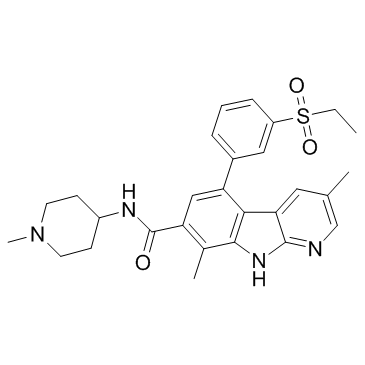934541-31-8
| Name | 5-(3-ethylsulfonylphenyl)-3,8-dimethyl-N-(1-methylpiperidin-4-yl)-9H-pyrido[2,3-b]indole-7-carboxamide |
|---|---|
| Synonyms |
5-[3-(Ethylsulfonyl)phenyl]-3,8-dimethyl-N-(1-methyl-4-piperidinyl)-1H-pyrido[2,3-b]indole-7-carboxamide
TAK-901 5-[3-(Ethylsulfonyl)phenyl]-3,8-dimethyl-N-(1-methyl-4-piperidinyl)-9H-pyrido[2,3-b]indole-7-carboxamide 9H-Pyrido[2,3-b]indole-7-carboxamide, 5-[3-(ethylsulfonyl)phenyl]-3,8-dimethyl-N-(1-methyl-4-piperidinyl)- cc-11 pound not TAK901 pound not TAK 901 |
| Description | TAK-901 is a multi-targeted aurora inhibitor with IC50s of 21 and 15 nM for aurora A and B, respectively. |
|---|---|
| Related Catalog | |
| Target |
Aurora A:21 nM (IC50) Aurora B:15 nM (IC50) |
| In Vitro | TAK-901 exhibits time-dependent, tight-binding inhibition of Aurora B, but not Aurora A. Consistent with Aurora B inhibition, TAK-901 suppresses cellular histone H3 phosphorylation and induces polyploidy. In various human cancer cell lines, TAK-901inhibits cell proliferation with effective concentration values from 40 to 500 nM. Examination of a broad panel of kinases in biochemical assays reveals inhibition of multiple kinases. However, TAK-901 potently inhibits only a few kinases other than Aurora B in intact cells, including FLT3 and FGFR2[1]. |
| In Vivo | In rodent xenografts, TAK-901 exhibits potent activity against multiple human solid tumor types, and complete regression is observed in the ovarian cancer A2780 model. TAK-901 also displayed potent activity against several leukemia models. TAK-901 induces pharmacodynamic responses consistent with Aurora B inhibition and correlating with retention of TAK-901 in tumor tissue[1]. |
| Kinase Assay | Enzyme activities of Aurora A/TPX2 and Aurora B/INCENP complexes are assayed at room temperature in buffer containing serially diluted TAK-901, and the product is quantified using IMAP detection reagents. Aurora A/TPX2 (2 nM) is assayed with 100 nM FL-Kemptide and 1 mM ATP. Aurora B/INCENP (0.8 nM) is assayed with 100 nM 5-carboxy-fluorescein-GRTGRRNSI-NH2 (FL-PKAtide) and 10 mM ATP. For time-dependent inhibition, Aurora B/INCENP is incubated with TAK-901 for 1 hour at room temperature followed by addition of 150 mM ATP to initiate the reaction[1]. |
| Cell Assay | Cells are plated in 96-well microtiter plates and incubated with serial dilutions of TAK-901 for 72 hours. Cell proliferation is determined by ELISA analysis of bromodeoxyuridine (BrdUrd) incorporation into DNA. IMR-90 immortalized lung fibroblasts are seeded in 96-well microtiter plates and cultured for 3 to 4 days until confluent. Cells are then incubated with serial dilutions of TAK-901 for 72 hours. The MTS assay is conducted[1]. |
| Animal Admin | Mice: Tumor-bearing mice or rats are treated intravenously twice daily (b.i.d.) with either vehicle or TAK-901 on 2 consecutive days per week or every other day for 2 or 3 cycles. The antitumor activity of TAK-901 in human tumor and leukemia xenograft models are monitored[1]. Nude rats bearing A2780 tumors averaging 250 to 500 mg receive an intravenous dose of TAK-901. Plasma samples are collected by terminal cardiac puncture under CO2 anesthesia. Tumors are dissected and snap-frozen at -80°C[1]. |
| References |
| Density | 1.3±0.1 g/cm3 |
|---|---|
| Boiling Point | 761.7±60.0 °C at 760 mmHg |
| Molecular Formula | C28H32N4O3S |
| Molecular Weight | 504.644 |
| Flash Point | 414.5±32.9 °C |
| Exact Mass | 504.219513 |
| PSA | 107.03000 |
| LogP | 3.65 |
| Vapour Pressure | 0.0±2.6 mmHg at 25°C |
| Index of Refraction | 1.685 |
| Storage condition | -20℃ |
